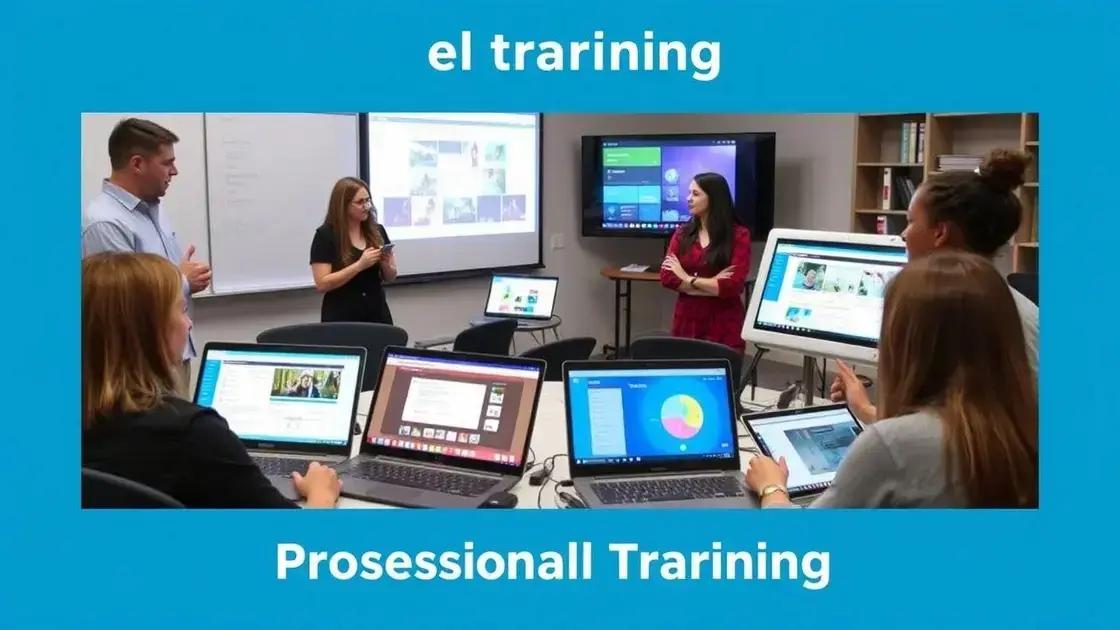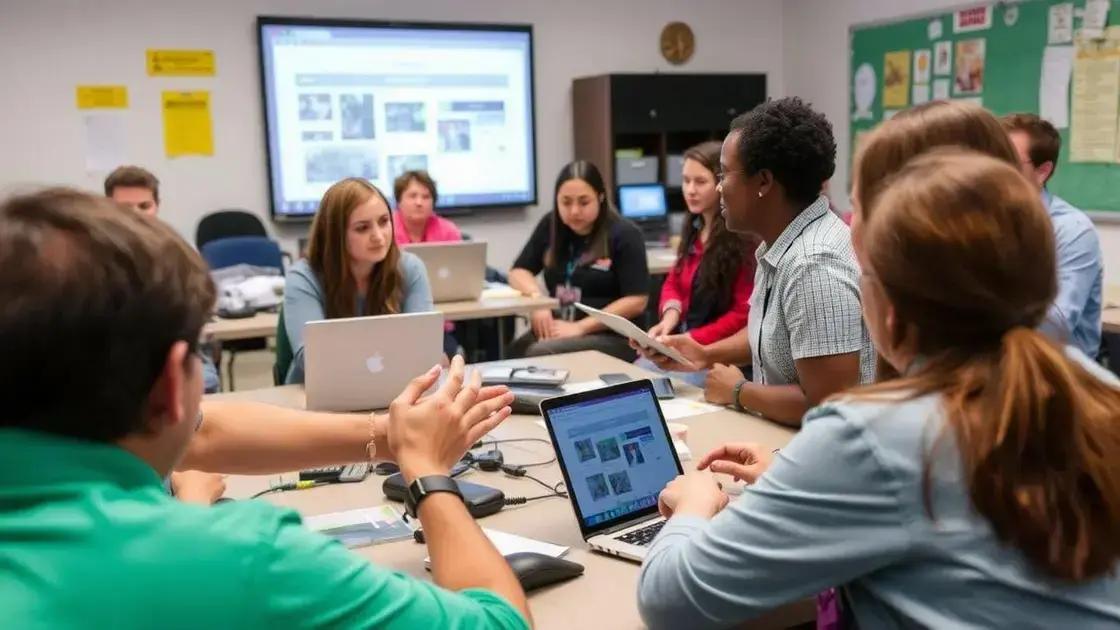Edtech tool adoption: how it can transform learning

Anúncios
Edtech tool adoption enhances learning by providing personalized experiences, increasing engagement, and supporting educators through effective training and evaluation of technology in the classroom.
Edtech tool adoption is changing how educators and students interact and learn. Have you ever wondered how these tools could enhance education? Let’s dive in and uncover their potential benefits.
Anúncios
Understanding edtech tools
Understanding edtech tools is essential for anyone looking to improve education. These technologies enhance the learning experience, making it more engaging and effective. In this section, we explore what edtech tools are and their significance in the modern classroom.
What are edtech tools?
Edtech tools encompass a range of digital resources used to facilitate learning. They include software, applications, and platforms designed for educational purposes. Some examples are Learning Management Systems (LMS), educational apps, and virtual classrooms.
Anúncios
These tools provide various functionalities, from offering interactive lessons to tracking student progress. Educators can tailor their teaching strategies to fit students’ needs better, ultimately fostering a more productive learning environment.
Benefits of using edtech tools
- Enhanced engagement: Students find learning more enjoyable with interactive platforms.
- Accessibility: Many tools are designed for all learners, including those with special needs.
- Real-time feedback: Teachers can monitor student performance instantly.
- Resource rich: Edtech tools come with vast resources, allowing for diverse materials.
The integration of edtech tools into education has transformed traditional teaching methods. With features like gamification, students are motivated to participate actively in their learning journey. Teachers can also create personalized learning paths based on individual student assessments and learning styles.
As more educators adopt these tools, it becomes crucial to understand their capabilities. Investing in proper training for both teachers and students ensures these tools are used effectively, maximizing their impact on education.
Key benefits of adopting edtech
Adopting edtech brings transformative benefits that enhance both teaching and learning processes. These advantages can significantly improve student outcomes and teacher efficiency. Let’s explore some of the key benefits.
1. Personalized Learning
One of the most significant advantages of edtech adoption is the capability for personalized learning. Teachers can tailor lessons to meet individual student needs, helping them to learn at their own pace. Using data analytics, educators can identify areas where students struggle and offer targeted resources accordingly.
2. Increased Engagement
Students are more motivated when using interactive tools. Edtech often incorporates elements like gamification, which makes learning fun and engaging. This increased engagement can lead to better retention of information and improved overall academic performance.
- Interactive lessons: Tools such as simulations and multimedia presentations captivate students.
- Collaboration opportunities: Many platforms allow students to work together, fostering teamwork and communication skills.
- Immediate feedback: Students receive instant responses on their performance, allowing for quick adjustments.
- Variety of resources: Access to a wide range of materials caters to different learning styles.
The benefits of adopting edtech extend beyond individual performance. Schools can experience greater efficiency, as administrative tasks become streamlined through digital platforms. For example, grading can be automated, freeing up teachers to focus more on instruction rather than paperwork.
Moreover, edtech can enhance communication between teachers, students, and parents. Platforms often feature messaging systems or tracking tools that keep all parties informed about progress, assignments, and areas needing attention. This collaboration helps create a supportive learning environment.
Challenges in edtech tool integration
Integrating edtech tools in education can be challenging, even though the benefits are significant. Understanding these challenges is crucial for effective implementation and successful adoption.
1. Resistance to Change
Many educators may feel hesitant to adopt new technologies. This resistance often stems from comfort with traditional teaching methods. Additionally, some may doubt the effectiveness of edtech tools. Providing training and support can help ease these fears and encourage a more welcoming attitude toward change.
2. Technical Issues
Another common challenge involves technical problems. Schools may face issues like inadequate infrastructure or lack of reliable internet access. These hurdles can severely hamper the integration process. Ensuring that schools have the proper bandwidth and technical support is essential for smooth implementation.
- Inconsistent access: Not all students may have equal access to devices and the internet.
- Software compatibility: Various tools may not work well together, causing frustration.
- Over-reliance on technology: Some educators might lean too heavily on tools rather than personal engagement.
Professional development plays a key role in overcoming these challenges. By providing teachers with ongoing support and training, schools can help them feel more confident in using edtech tools. This training can also clarify how to integrate these tools into their lesson plans effectively.
Furthermore, involving teachers in the selection of edtech tools can foster a sense of ownership and responsibility. When educators feel they have a say in the tools they use, they are more likely to embrace these technologies in their classrooms.
Strategies for successful adoption

Implementing edtech tools successfully requires thoughtful strategies. These methods ensure that educators and students can harness the full potential of technology in the classroom. Let’s explore effective strategies for adoption.
1. Provide Comprehensive Training
Training is essential for teachers to feel comfortable using new tools. Regular workshops and hands-on sessions can help educators understand how to integrate edtech into their teaching. The aim is to make them confident and proficient in using various technologies.
2. Foster a Collaborative Environment
Creating a culture of collaboration can lead to successful adoption. Teachers should share their experiences and best practices with each other. Utilizing peer-to-peer support helps in overcoming barriers and encourages a team approach to learning.
- Establish mentorship programs: Experienced teachers can guide those new to edtech.
- Encourage feedback: Regular discussions about what works and what doesn’t can help refine the adoption process.
- Group projects: Foster collaboration among students to demonstrate effective use of edtech tools.
Involving students in the selection process of edtech tools can also promote engagement. When students have a say in what technologies are used, they become more invested in their learning. Providing optional technology choices based on students’ interests can enhance their overall experience.
A gradual implementation approach allows for adjustments along the way. Schools can start with a few tools and expand as confidence and proficiency grow. This step-by-step method helps in managing potential issues without overwhelming educators and students.
Evaluating the right edtech tools
Evaluating the right edtech tools is crucial for successful implementation in classrooms. With so many options available, making informed choices helps ensure that the tools selected meet both educational needs and enhance student learning.
1. Define Learning Objectives
Before selecting any edtech tools, it’s essential to identify the specific learning objectives. Understanding what you want to achieve sets a clear direction for the evaluation process. This alignment will help in finding tools that support your educational goals effectively.
2. Research and Comparison
After clarifying objectives, researching various options is the next step. Comparing different tools based on their features, usability, and overall effectiveness can guide decision-making. Consider user reviews and expert recommendations during this phase.
- Features: Look for tools that offer interactive elements, data tracking, and accessibility.
- User experience: Evaluate if the platform is intuitive and easy to use for both students and teachers.
- Cost: Assess if the tool fits within your budget while providing value.
- Integration: Ensure compatibility with existing systems and tools used in the school.
Taking the time to involve teachers and students in the evaluation process can provide valuable insights. Their feedback on user experience can identify strengths and weaknesses that others may overlook. Additionally, piloting a few tools in the classroom can help gauge effectiveness.
Integrating student input can ensure that the chosen edtech tools resonate with learners, maximizing engagement. When students have an interest in the tools they use, they are more likely to participate actively and demonstrate improved outcomes.
Real-world case studies in edtech
Real-world case studies in edtech provide valuable insights into how technology can transform education. These examples illustrate successful implementations and demonstrate the impact of various tools in different learning environments.
1. Personalized Learning in Action
One remarkable case involves a school that implemented an adaptive learning platform. This platform tailored educational content to each student’s pace and learning style. As a result, teachers could focus their efforts on students needing additional support, leading to improved overall performance.
2. Enhanced Collaboration
Another example can be found in a district that adopted collaborative platforms for group projects. Students worked together through virtual spaces, sharing resources and engaging in discussions. This approach not only improved teamwork skills but also fostered creativity and critical thinking.
- Increased engagement: Students were more excited and motivated to participate.
- Real-time feedback: Teachers could monitor group progress and intervene when necessary.
- Broadened perspectives: Working with peers from different backgrounds helped students learn from one another.
Additionally, there are instances where schools have used data analytics tools to track student progress. By analyzing performance data, educators could identify trends and adapt their teaching methods effectively. Early interventions for struggling students were made possible, greatly enhancing their chances of success.
These case studies highlight the diversity of applications for edtech tools. Schools, ranging from small rural districts to large urban centers, have successfully integrated technology to meet the needs of their students. Sharing these success stories can inspire others to explore similar innovations.
Future trends in educational technology
Future trends in educational technology promise to change how students learn and teachers instruct. As innovation continues to evolve, keeping an eye on these trends can prepare educators for what’s next.
1. Artificial Intelligence in Education
Artificial intelligence (AI) is set to play a key role in edtech. It can personalize learning experiences based on individual student needs and preferences. Imagine a platform that adapts in real-time to ensure each student receives the support they need.
2. Virtual and Augmented Reality
Virtual reality (VR) and augmented reality (AR) are already making waves in education. These technologies provide immersive experiences, allowing students to explore subjects in ways that textbooks cannot offer. For instance, students can take virtual field trips to historical sites or conduct science experiments in a safe environment.
- Enhanced engagement: AR and VR capture students’ attention like never before.
- Interactive learning: These technologies promote active participation in lessons.
- Real-world simulations: Students can practice skills in controlled scenarios before applying them in real life.
Additionally, learning analytics is becoming increasingly important. Schools will use data to analyze student performance trends, helping educators make informed decisions. By utilizing data effectively, teachers can tailor their approaches and improve student outcomes.
Furthermore, the rise of mobile learning is shaping how education is delivered. With increased access to smartphones and tablets, students can learn anytime and anywhere. This flexibility allows them to engage with learning materials outside the classroom, leading to a more comprehensive educational experience.
Training staff for effective edtech usage

Training staff for effective edtech usage is essential for maximizing the benefits of technology in education. Schools need to provide comprehensive training to ensure teachers feel confident and competent using these tools.
1. Comprehensive Training Programs
Implementing robust training programs is a great start. These programs should include hands-on sessions, workshops, and ongoing support. By using real-world scenarios, educators can see how edtech tools fit into their teaching strategies.
2. Peer Mentoring
Establishing peer mentoring can enhance the training experience. More experienced teachers can guide their colleagues in effectively using edtech tools. This system creates a collaborative environment where teachers can share best practices.
- Support networks: Encourage teachers to form support groups for addressing challenges together.
- Regular check-ins: Schedule meetings to discuss progress and share experiences.
- Resource sharing: Provide platforms for teachers to exchange lesson plans and tips.
Additionally, training should be ongoing. As technology continues to evolve, so too should the training for educators. Staying current with new features, updates, and tools ensures that teachers are well-prepared in their classrooms. Incorporating feedback from educators into training programs can help refine and improve them continuously.
Lastly, providing incentives for participation can encourage staff engagement. Recognizing teachers for completing training or successfully implementing new tools creates a positive culture around the usage of edtech. This recognition can motivate others to embrace technology in their teaching methods.
FAQ – Frequently Asked Questions about Edtech Tool Adoption
What are edtech tools?
Edtech tools are digital resources designed to enhance learning experiences, such as learning management systems, educational apps, and interactive platforms.
How can training help teachers use edtech effectively?
Training equips teachers with the necessary skills and confidence to incorporate technology into their lesson plans successfully.
What are the benefits of personalized learning through edtech?
Personalized learning allows educators to tailor lessons to individual student needs, improving engagement and learning outcomes.
How do schools evaluate the effectiveness of edtech tools?
Schools assess edtech tools by analyzing student performance data, gathering feedback from educators, and monitoring engagement levels.






